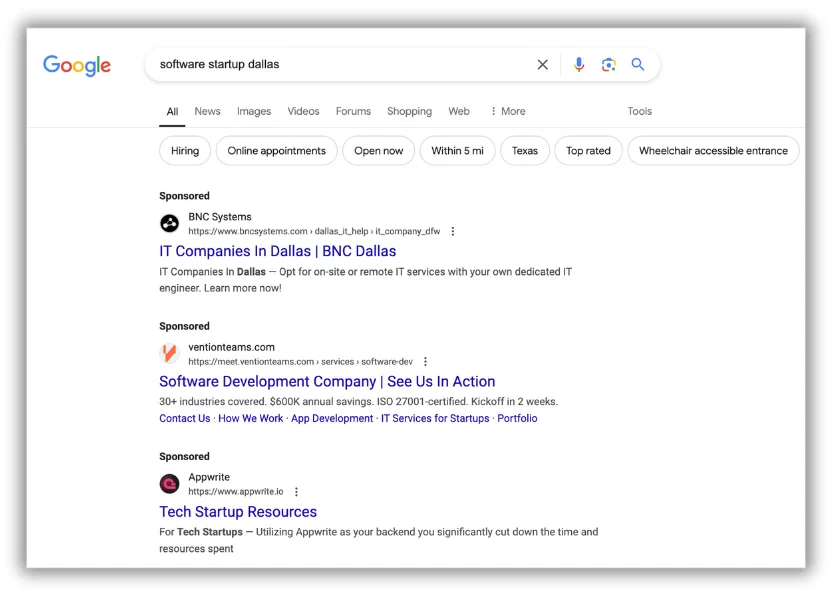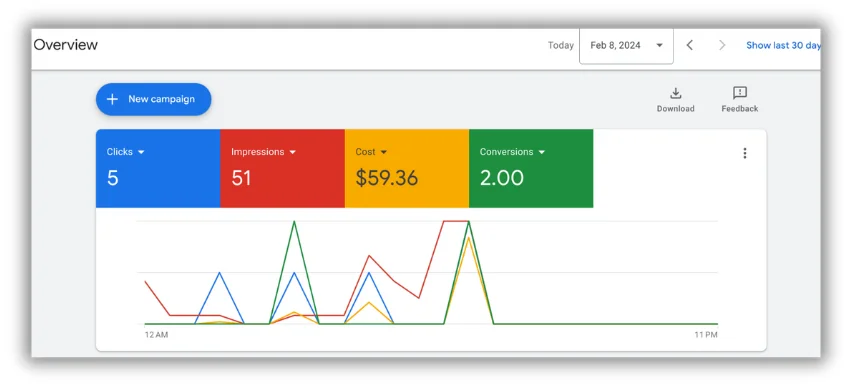Understanding Google Ads is essential for startups looking to expand their reach online. This article will explore Google Ads for startups, covering the basics of what it is and useful features, as well as strategies to help your new business thrive when using Google Ads.
Contents
What is Google Ads for startups?
Google Ads is an advertising platform that enables businesses to promote their products or services on Google’s search engine results pages (SERPs), YouTube, and other Google-owned websites.


Google Ads operates on a pay-per-click (PPC) model, meaning advertisers only pay when a user clicks on their ad. This cost-effective approach and Google Ads’ powerful targeting options, which allow businesses to reach specific demographics, locations, and interests, make it a popular choice for online advertising.
Starting your Google Ads journey is simple–all you need is a Google account, which will give you access to create a Google Ads account through their website or app.
? Want to learn more about search engine marketing on Google? Get the free guide >> PPC 101: Complete Guide to Google Ads
Benefits of Google Ads for startups
Why consider Google Ads for your startup? Here are some of the biggest benefits.
Cost-effective targeting
One of the key benefits of Google Ads for startups is that you aren’t paying for wasted views. When you set up Google Ads campaigns, you’re defining who will see your ads based on what they search, where they are located, and even their interests. This minimizes spending on advertising to people unlikely to be interested in your product or service.
Relevance
Google Ads offers granular control over matching your ads to search queries and interests. For example, if your startup sells eco-friendly sneakers, you can ensure your advertisements appear when people search for “sustainable shoes” or “recycled footwear.” This tailored approach improves ad performance and ultimately your return on investment.
Diverse platforms
The Google Ads network has a massive reach. Your ads can appear in traditional search results and on various platforms. However, based on my experience with search campaigns, the best conversions come from using just Google Search rather than search partners and display networks. These include:
- Google partner websites with relevant content.
- Gmail and other Google-owned properties.
- YouTube, both in videos and as display ads.
Customization
Successful advertising speaks to an audience’s needs and desires. Google Ads lets you refine your messaging by:
- Crafting multiple ad variations.
- Employing A/B testing to fine-tune what works best.
- Taking advantage of dynamic ad options that automatically adjust for different viewers.
Performance tracking
With data at your fingertips, you can continually understand how your ads are performing. The dashboard shows you clicks, impressions, costs, and helps determine what’s working and what isn’t.


? What results can you expect from Google Ads? Download our latest Google Ads Benchmarks to find out!
Flexibility
Google Ads makes campaign management accessible and adaptable. Here’s why that’s critical for startups:
- Scaling is simple: As your budget grows, your ad campaigns can easily expand with you.
- Pause and pivot: Although frequently stopping and starting your ads is not recommended, you do have the option to do so. It’s important to set a monthly budget that suits your comfort level and adhere to it. However, the Google Ads dashboard offers flexibility, allowing you to pause ads or adjust your targeting strategy in response to market changes at any time.
What’s a good Google Ads budget for startups?
I often receive questions about budgeting, with people asking what their daily/monthly budget should be.
Google Ads budgeting factors
There are a number of factors to consider when answering this question.
Industry and competition
Some industries have significantly higher average costs per click (CPC) than others. More competitive keywords within your industry will increase bidding costs. Thorough keyword research is key to understanding costs.


Our Google Ads benchmarks can also give you a good guide for the CPC you can expect from your campaigns.
? Need help finding the right keywords? Try our Free Keyword Tool!
Customer Lifetime Value (CLV)
Knowing the average lifetime value of a customer helps you decide how much you’re willing to spend to acquire them. If your CLV is high, you can afford to be more aggressive with bidding and your budget.
Business goals
Are you primarily focused on brand awareness, website traffic, or immediate conversions? Your goals will inform the aggressiveness of your budget.
Testing period
Starting with a smaller budget allows you to test, analyze data, and refine your strategy before scaling up.
Starting point budgeting guidelines
Since you’re new, err on the conservative side while experimenting.
- Minimum starting budget: Consider $20-$50 per day as a baseline. This gives you enough for a few clicks and initial data.
- Recommended average range: Most small businesses should allocate between $1,000-10,000 per month for Google Ads.
- Adjusting budget: Continually monitor your campaign performance and adjust the budget based on results. It’s okay to start small and gradually increase once you have more data.
Tips for effective Google Ads for startups
Ready to get started? Follow these best practices for effective Google Ads for startups.
Find the right keywords
Choosing the right keywords is the heart of effective search advertising. With Google Ads, you carefully select the words and phrases that will trigger your ads to appear.
For example, if you sell running gear, you’d want keywords like “running shoes” or “marathon training gear.” This ensures your ads are seen by people actively searching for your products, and not someone looking for information about “running for office.” Optimizing your keywords means getting your products in front of the people most likely to buy them.
Target the right location
Location-based targeting is great for both broad and local startups. For a global startup, you can segment campaigns according to regions where your product is a fit. For a local startup, it’s about getting those ads in front of your nearest potential customers.


Find the right geographic targeting strategy for your specific startup to make sure your ads are showing to those most likely to become your customers.
Write attention-grabbing headlines and detailed ad descriptions
Google’s Quality Score evaluates the overall quality of your ads, and a major factor in that score is ad relevance. Clear headlines and descriptions that match the user’s search intent can improve your click-through rate, which impacts Quality Score and ad relevance.
Tips for strong headlines
Your headline is the first thing potential customers see. Make it count! It needs to be clear, concise, and captivating. Here’s how:
- Incorporate keywords: This boosts relevance and visibility for the right searches.
- Focus on benefits: What problem does your product/service solve? Highlight that!
- Use action words: Use powerful verbs like “Discover,” “Try,” “Save,” to inspire clicks.
- Incorporate numbers and stats: Concrete figures create urgency (e.g., “Limited Time: 50% Off”).
Tips for clear ad descriptions
This is your space to provide additional context and benefits. Maximize the descriptive text to:
- Expand on your offer: Elaborate on what the headline promises.
- Include your unique selling position: What makes you different from competitors? Showcase that here.
- Add strong calls to action: Use clear statements like “Shop Now,” “Learn More,” or “Sign Up Today.”
Maximizing headlines and descriptions
Here are some tips for both headlines and ad descriptions.
- Pay attention to maximum length: Use all available character limits. Google Ads has specific limits for headlines and descriptions–take full advantage of those to provide more information.
- Integrate keywords: Carefully and naturally work your target keywords into your headlines and descriptions. This signals to Google that your ad is highly relevant to those search terms.
- Try variations: Try different headlines and descriptions for the same ad group to see which ones resonate most with your target audience.


Get started with Google Ads for startups
The digital era has undoubtedly transformed advertising. Gone are the simple days of dominating the phone book; a successful internet presence is today’s equivalent. At its core, the goal of advertising hasn’t changed–it’s about getting seen by the right people at the right time to grow your business. Google Ads provides a powerful and flexible platform for startups to achieve that goal.
Whether you’re a complete newbie to paid advertising or transitioning from more traditional strategies, remember these essentials:
- Thorough research: Understanding your target audience, industry competition, and the mechanics of Google Ads is vital before taking the first step.
- Testing and experimentation: There’s no one-size-fits-all answer to budget or perfect ad copy. A/B testing is your friend – it allows you to gather data and find what works best for you.
- Embrace agility: Successful Google Ads campaigns aren’t about “set-it-and-forget-it.” Regular optimization, including keyword, bid, and landing page adjustments, ensures you’re getting the most out of your budget.
While launching yourself into a new space is daunting, taking this leap will likely prove far more fruitful than those old full-page phone book ads. Think of Google Ads as the modern toolbox to boost visibility, build a reputation, and ultimately attract new customers who understand the value you provide. It truly is a tool for democratizing your reach and growing your business in a way that couldn’t exist pre-internet.